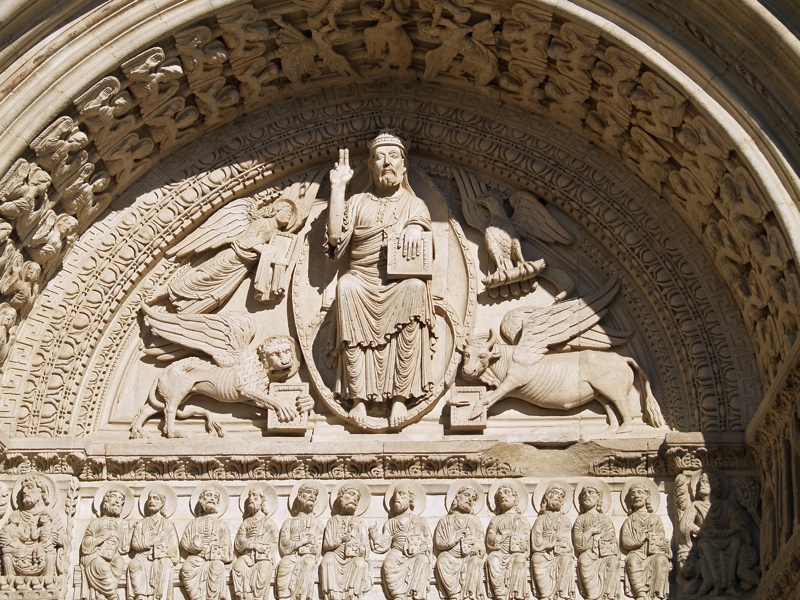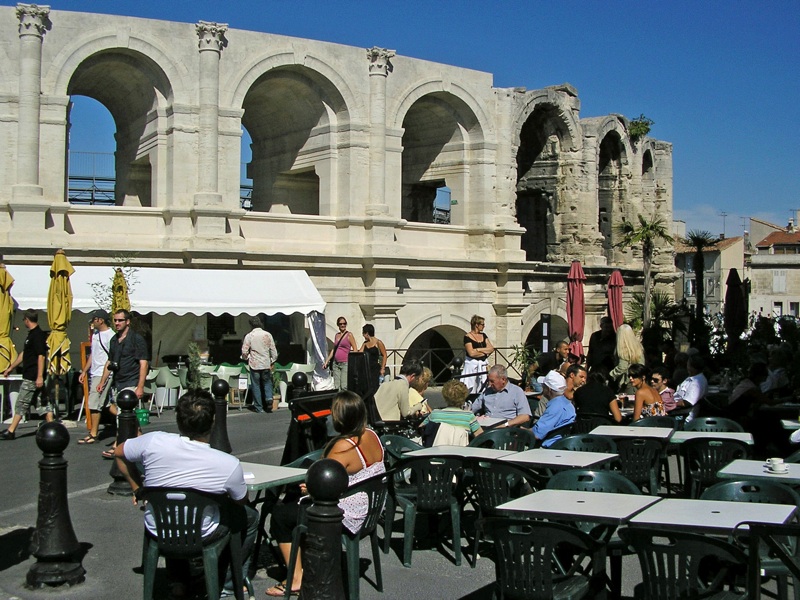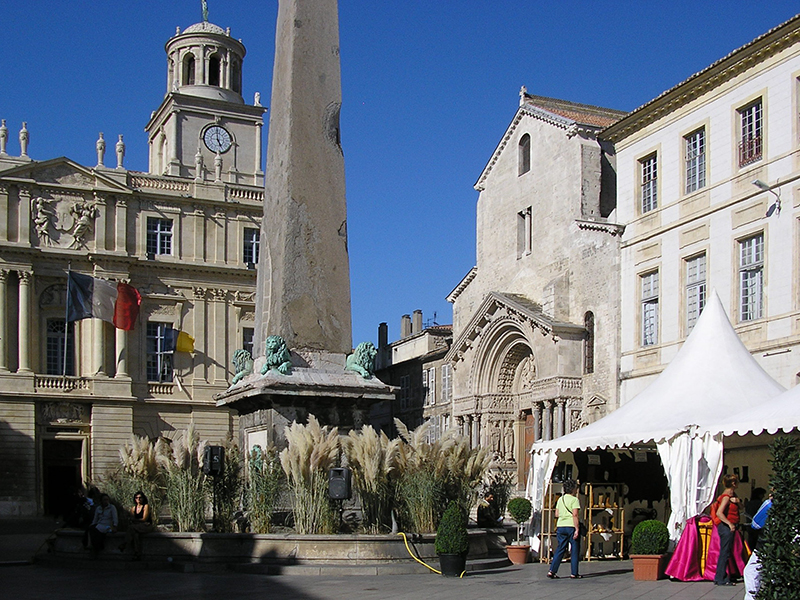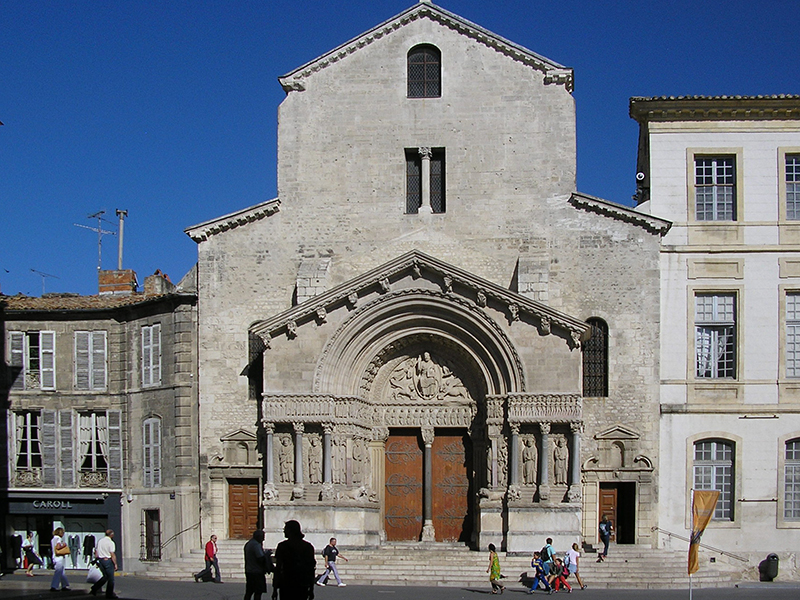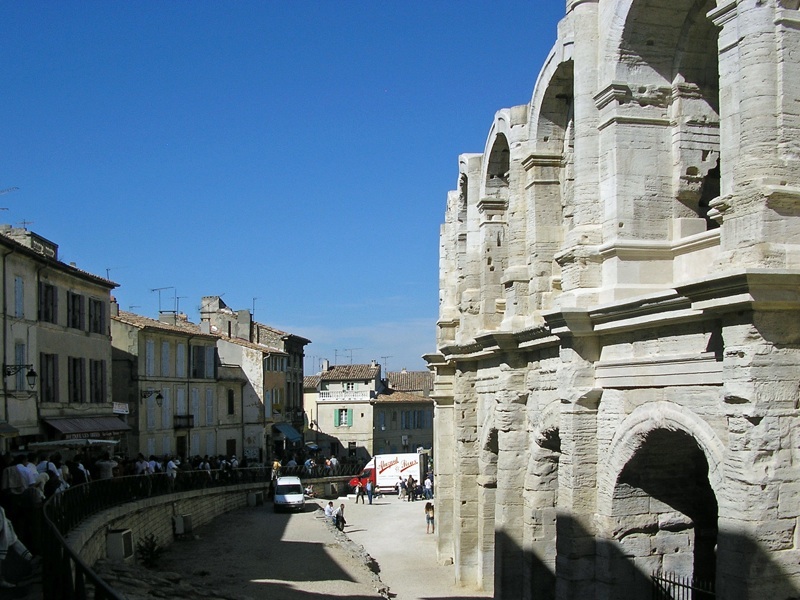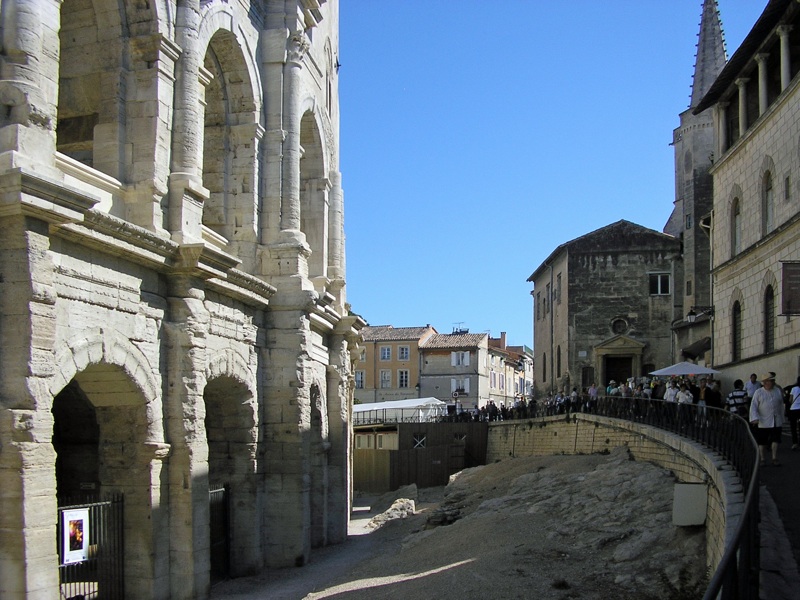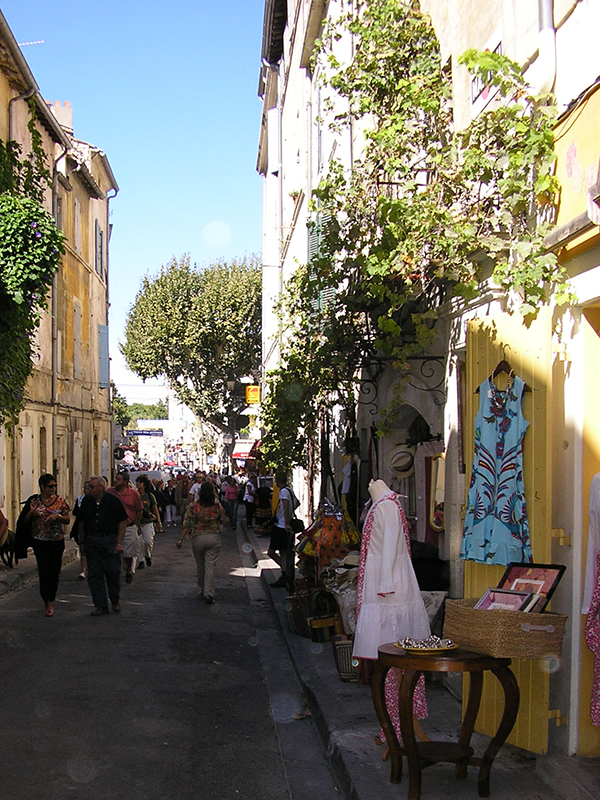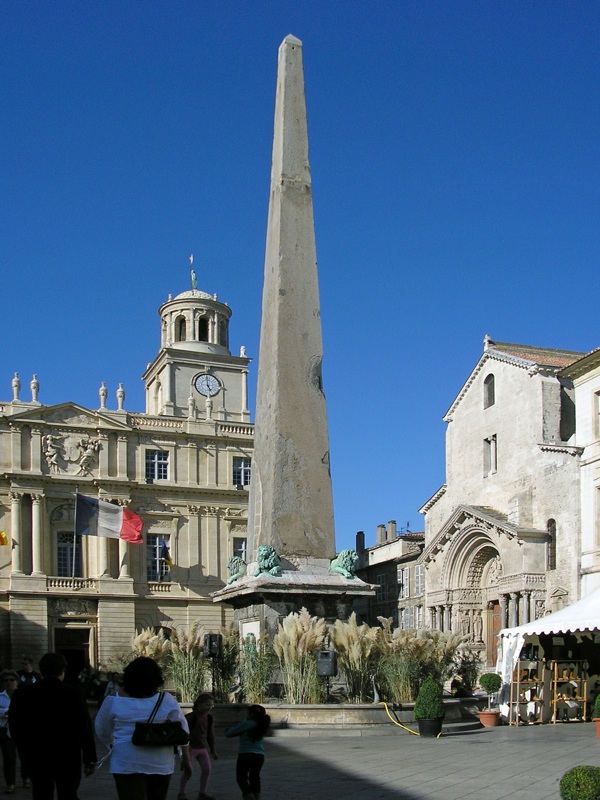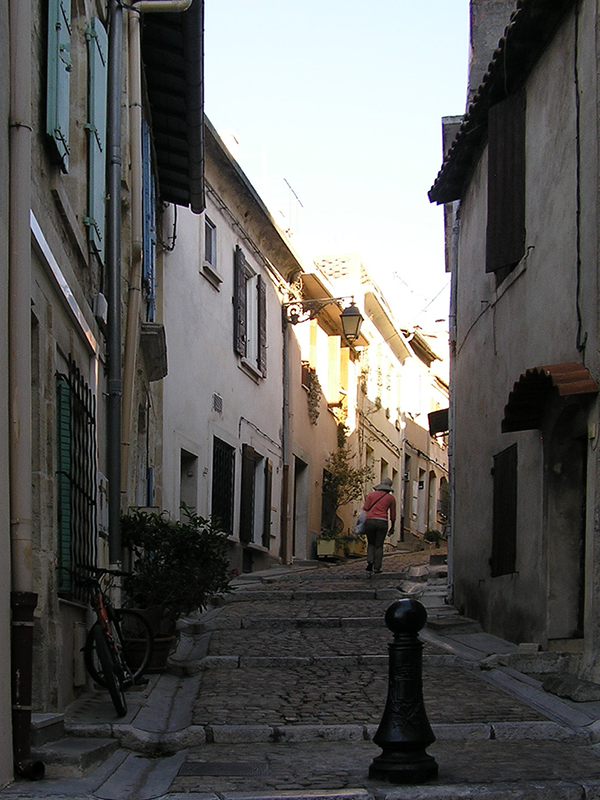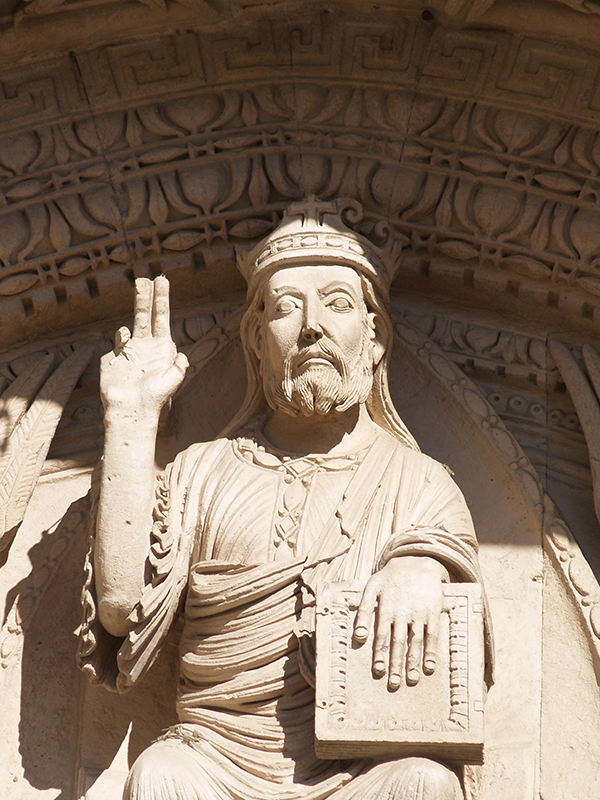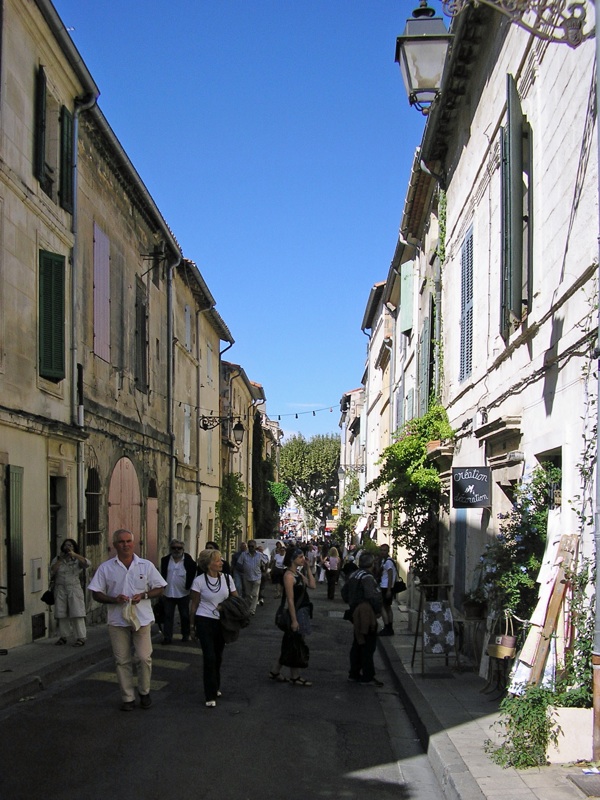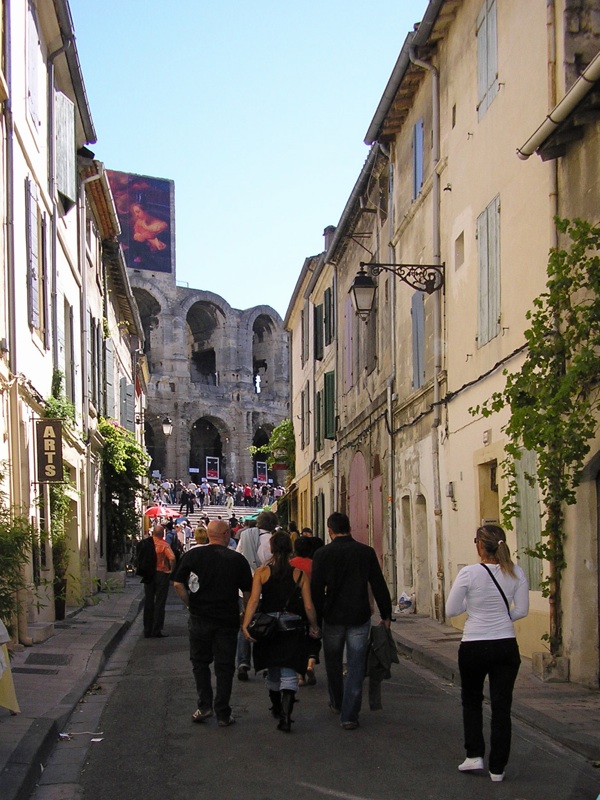Photo gallery
 and 50 km northwest of Marseille
and 50 km northwest of Marseille  (➤ map)(➤ map). Arles is known primarily for its Roman monuments (including the great arena from the 1st century AD) and Romanesque (Église Saint-Trophime from the 12th century), as well as the city of Vincent van Gogh, who lived and worked here in 1888-1889.
(➤ map)(➤ map). Arles is known primarily for its Roman monuments (including the great arena from the 1st century AD) and Romanesque (Église Saint-Trophime from the 12th century), as well as the city of Vincent van Gogh, who lived and worked here in 1888-1889.The city was founded as a Greek colony in the 6th century BC. (called Theline); soon afterwards it was conquered - or rather recaptured - by the Celts (the indigenous people of the region) and was then called Arelate. In 123 BC it was conquered by the Romans and from then on it was one of the most important centers of the empire; later the role of Arles, located in a key place on the Rhône, at the strategic crossroads of the then communication routes, grew even more - hence the rapid development, the construction of defensive walls and the forum, the construction of an arena, theater and other buildings, some of which have survived to this day. In the 4th and 5th centuries, Roman troops were quartered here. During the late empire, Arles was an important center for the Christianization of Gaul (the first bishop is mentioned in the third century). In 476 it was conquered by the Visigoths.
Later, the city passed from hand to hand many times. In the middle of the 9th century, it became the capital of the so-called Frankish The Kingdom of Arles, covering Burgundy and part of Provence, but destroyed in repeated invasions by various enemies, began to lose its importance, although it also had better periods - for example, in the 12th century it was for some time the residence of Frederick Barbarossa, who granted Arles city rights. In 1378, Emperor Charles IV gave what remained of the Kingdom of Arles to the Dauphin of France - later King Charles VI of France; henceforth, the history of Arles was bound up with the history of France.
The most important monument of Arles from Roman times is the huge Arena (Les Arènes)
 from the 1st century AD, also known as the amphitheatre; other ancient monuments - the theater
from the 1st century AD, also known as the amphitheatre; other ancient monuments - the theater  , Baths of Constantine
, Baths of Constantine  , crypto portico
, crypto portico  and necropolis Les Alyscamps
and necropolis Les Alyscamps  , see below. The
, see below. The  marker stands for the location of the Musée de l'Arles et de la Provence antiques.
marker stands for the location of the Musée de l'Arles et de la Provence antiques. , is the church of St. Trofim
, is the church of St. Trofim  and the adjacent monastery, with its famous courtyard and cloisters. Vincent Van Gogh's stay in Arles is related to La Fondation van Gogh
and the adjacent monastery, with its famous courtyard and cloisters. Vincent Van Gogh's stay in Arles is related to La Fondation van Gogh  and L'Espace van Gogh
and L'Espace van Gogh  (see below). A special attraction of Arles is considered to be the best ethnographic museum in Provence - Museon Arlaten (29, rue de la République), founded in 1896 by the Provencal poet , winner of the 1904 Nobel Prize in Literature, Frédéric Mistral.
(see below). A special attraction of Arles is considered to be the best ethnographic museum in Provence - Museon Arlaten (29, rue de la République), founded in 1896 by the Provencal poet , winner of the 1904 Nobel Prize in Literature, Frédéric Mistral.Arena
 (Les Arènes) in Arles dates back to the 1st century CE. It was one of the largest: it is 136 m long and 109 m wide; two floors, with 60 arcades each, could accommodate over 20,000 people. After the fall of the Roman Empire, the arena was transformed into a fortress; then it became a source of building materials, and finally - a shelter for the homeless, almost a separate housing estate with several hundred houses, chapels, a square, etc. The original shape (after expropriation and demolition) was restored only in 1830.
(Les Arènes) in Arles dates back to the 1st century CE. It was one of the largest: it is 136 m long and 109 m wide; two floors, with 60 arcades each, could accommodate over 20,000 people. After the fall of the Roman Empire, the arena was transformed into a fortress; then it became a source of building materials, and finally - a shelter for the homeless, almost a separate housing estate with several hundred houses, chapels, a square, etc. The original shape (after expropriation and demolition) was restored only in 1830.Currently, various events are held here, the most important of which are bullfights. Many sources say that these are fights "according to Provençal rules", where it is not about killing a bull, but about tearing off the decorations from the animal's horns; however, during Easter and the first weekend in September, "Spanish-style" fights are also organized here, where bulls are killed.
The main square of Arles is Place de la République
 . Next to it stands the town hall (built in 1673-1675 according to the plans of J. Hardouin-Mansart) and the most important church of Arles - the church of St. Trophim, and in the middle - an Egyptian obelisk with a height of 15 meters, once found in the amphitheater and in 1676 placed on the square.
. Next to it stands the town hall (built in 1673-1675 according to the plans of J. Hardouin-Mansart) and the most important church of Arles - the church of St. Trophim, and in the middle - an Egyptian obelisk with a height of 15 meters, once found in the amphitheater and in 1676 placed on the square.Church of St. Trofim
 (Église Saint-Trophime) at Place de la République, together with the famous monastery adjacent to it, is considered one of the most important works of Romanesque architecture in the region.
(Église Saint-Trophime) at Place de la République, together with the famous monastery adjacent to it, is considered one of the most important works of Romanesque architecture in the region.The church dates from the 12th century; the present square belfry - from the 13th century (when it replaced the previously existing one), with the upper floor rebuilt in the 17th century; monastery - partly from the 12th century and partly from the 14th century. The church used to be a cathedral, the seat of the archbishopric of Arles. After the French Revolution it lost its importance; now it is a parish church; from 1882 a minor basilica. Emperor Charles IV was crowned in the cathedral in 1365, as was his predecessor Frederick Barbarossa.
Perfectly preserved (restored in the 1990s) portal of the church of St. Trofima was built between 1180 and 1190. The representation of the Last Judgment, like the columns of the cloister of the monastery of St. Trofimo is considered one of the most outstanding achievements in the field of Romanesque sculpture in Provence.
Roman monuments in Arles
- Apart from the Arena, the most important Roman monuments in Arles are: the theater
 , the baths of Constantine
, the baths of Constantine  , cryptoportico
, cryptoportico and necropolis - Les Alyscamps
and necropolis - Les Alyscamps  . Little remains of the theater - fragments of statues, two columns, the remains of the stage and the auditorium; after the fall of the Roman Empire, it was a place of obtaining building materials, and then disappeared for a long time under newer buildings; it was rediscovered in the first half of the 19th century during archaeological excavations. There is also little left of the Baths of Constantine (Thermes de Constantin), dating from the 4th century. In the basement of the 17th-century chapel, a cryptoportico (Cryptoportique du Forum) has been preserved, the composition of the former forum, built at the end of the 1st century BC. Les Alyscamps - is an ancient cemetery, once of great importance - here was buried St. Trophimus and, according to legend, the title character of the Song of Roland. Later, the cemetery was gradually devastated (today it is an avenue with empty sarcophagi) - however, it remained a cult place: Dante described it in Divine Comedy, it was painted by Van Gogh and Gaugin. In the Musée de l'Arles et de la Provence antiques, marked on the map with the marker
. Little remains of the theater - fragments of statues, two columns, the remains of the stage and the auditorium; after the fall of the Roman Empire, it was a place of obtaining building materials, and then disappeared for a long time under newer buildings; it was rediscovered in the first half of the 19th century during archaeological excavations. There is also little left of the Baths of Constantine (Thermes de Constantin), dating from the 4th century. In the basement of the 17th-century chapel, a cryptoportico (Cryptoportique du Forum) has been preserved, the composition of the former forum, built at the end of the 1st century BC. Les Alyscamps - is an ancient cemetery, once of great importance - here was buried St. Trophimus and, according to legend, the title character of the Song of Roland. Later, the cemetery was gradually devastated (today it is an avenue with empty sarcophagi) - however, it remained a cult place: Dante described it in Divine Comedy, it was painted by Van Gogh and Gaugin. In the Musée de l'Arles et de la Provence antiques, marked on the map with the marker  , you can see exhibits found in Arles from various periods of history, including sarcophagi from Les Alyscamps, fragments of statues from the Théâtre Antique, etc.
, you can see exhibits found in Arles from various periods of history, including sarcophagi from Les Alyscamps, fragments of statues from the Théâtre Antique, etc.
Van Gogh's city
- In the years 1888-1889, Vincent Van Gogh lived in Arles for several months, residing for some time in the famous "yellow house" (today nonexistent) and creating over 300 works (paintings and drawings), including the most famous ones (although none none of them stayed in the city). In Arles, too, after a well-known incident of self-mutilation in December 1888, he ended up in the hospital L'Hotel-Dieu d'Arles
 (pl. F. Rey), from where he later moved to the plant in Saint-Rémy-de-Provence; this old hospital in Arles now functions as an exhibition space, a center for the artist's works, the so-called L'espace Van Gogh. Works by various contemporary artists, not only painters, related to the work of Van Gogh can also be seen at La Fondation van Gogh
(pl. F. Rey), from where he later moved to the plant in Saint-Rémy-de-Provence; this old hospital in Arles now functions as an exhibition space, a center for the artist's works, the so-called L'espace Van Gogh. Works by various contemporary artists, not only painters, related to the work of Van Gogh can also be seen at La Fondation van Gogh  (24bis, Rond Point des Arènes ).
(24bis, Rond Point des Arènes ).
Around Arles
- A few kilometers north-east of Arles, on the D17 road leading to Fontvieille, you can visit the famous Montmajour Abbey
 (L'abbaye Saint-Pierre de Montmajour) - a former Benedictine abbey, founded in 948. By the end of the 10th century, Montmajour Abbey had become one of the wealthiest abbeys in the region; from the 11th century it was the burial place of the rulers of Provence. During the French Revolution, the monastery was destroyed, then passed into private hands and fell into ruin, but in the 19th century it was restored and today it is considered one of the most important tourist attractions of Provence.
(L'abbaye Saint-Pierre de Montmajour) - a former Benedictine abbey, founded in 948. By the end of the 10th century, Montmajour Abbey had become one of the wealthiest abbeys in the region; from the 11th century it was the burial place of the rulers of Provence. During the French Revolution, the monastery was destroyed, then passed into private hands and fell into ruin, but in the 19th century it was restored and today it is considered one of the most important tourist attractions of Provence.
- Arles is located at the beginning of the Rhône delta, which branches here into two branches: the Grand Rhône (eastern) and the Petit Rhône (western) - an area of 930 km2, which is actually an island , surrounded by two arms of the river and to the south by the Mediterranean Sea, is called the Camargue. Part of the Camargue's surface is occupied by lakes, part by swamps, part by sand dunes. The entire area, with its specific flora and fauna (including many species of birds, including flamingos, the famous "white horses of the Camargue", etc.) - as "Parc Naturel Régional de Camargue" - is under protection. Camargue is of tourist importance primarily for lovers of wild nature (who can protect themselves against mosquitoes, which are a plague there); in addition, the town of Saintes-Maries-de-la-Mer is considered worth visiting
 , the destination of the annual Roma pilgrimage paying homage to its patron saint, St. Sarah, and the medieval fortress of Aigues-Mortes
, the destination of the annual Roma pilgrimage paying homage to its patron saint, St. Sarah, and the medieval fortress of Aigues-Mortes  , once built as a port fortress, today about 5 km from the sea. For amateurs, it may also be interesting to know that in the Camargue bulls are bred for fighting in arenas (also Spanish).
, once built as a port fortress, today about 5 km from the sea. For amateurs, it may also be interesting to know that in the Camargue bulls are bred for fighting in arenas (also Spanish).
Additional information
- St. Trophimus, to whom the main church in Arles is dedicated, was the first local bishop (one of the bishops sent in the 3rd century by Pope Fabian to Gaul). From the 9th century, the cult of the saint developed in Arles - pilgrims heading to Santiago de Compostela stopped at his grave.
- Every year in Arles there is another edition of the famous international photography festival, "Rencontres d'Arles"; Arles is also home to the École Nationale Supérieure de la Photographie, one of the most important photography schools in France..
